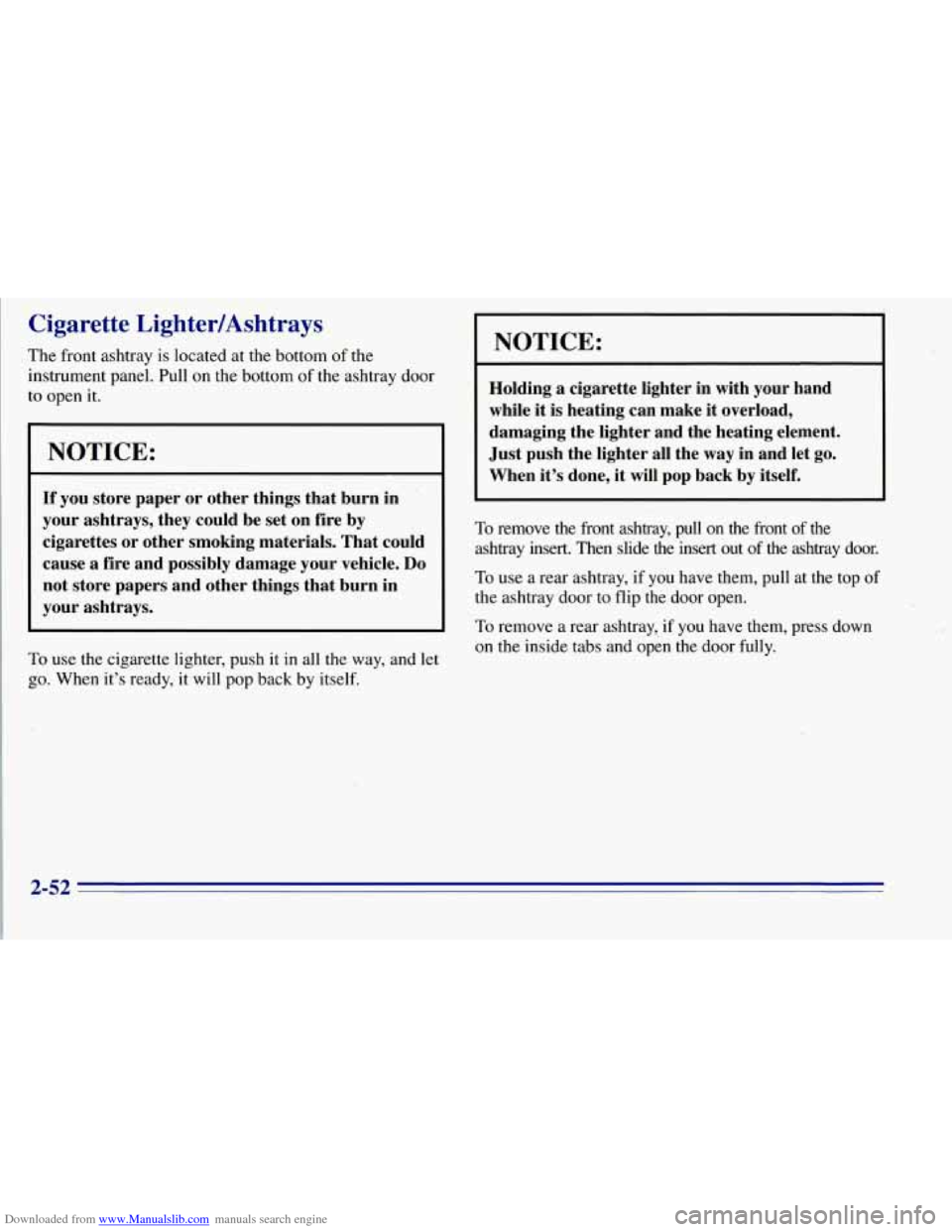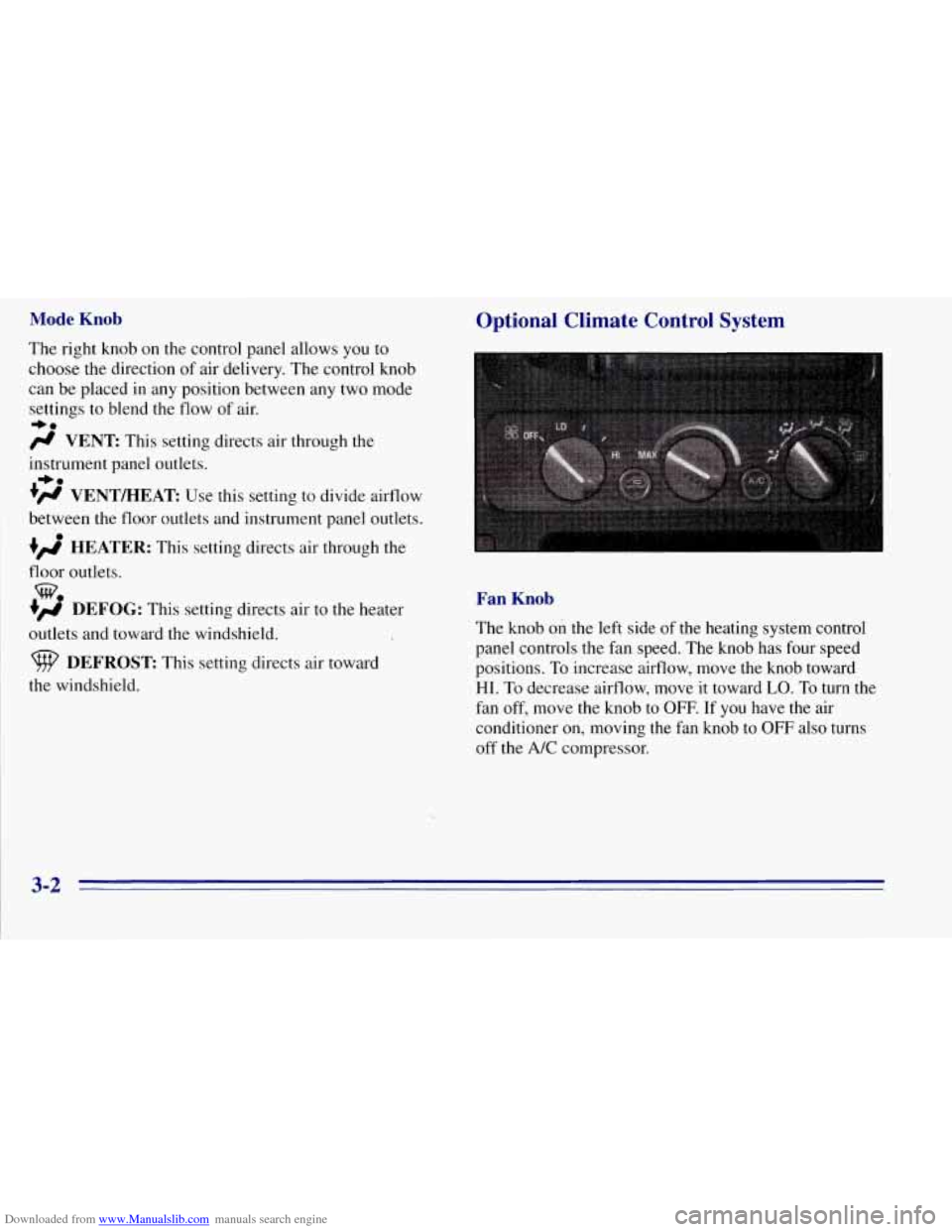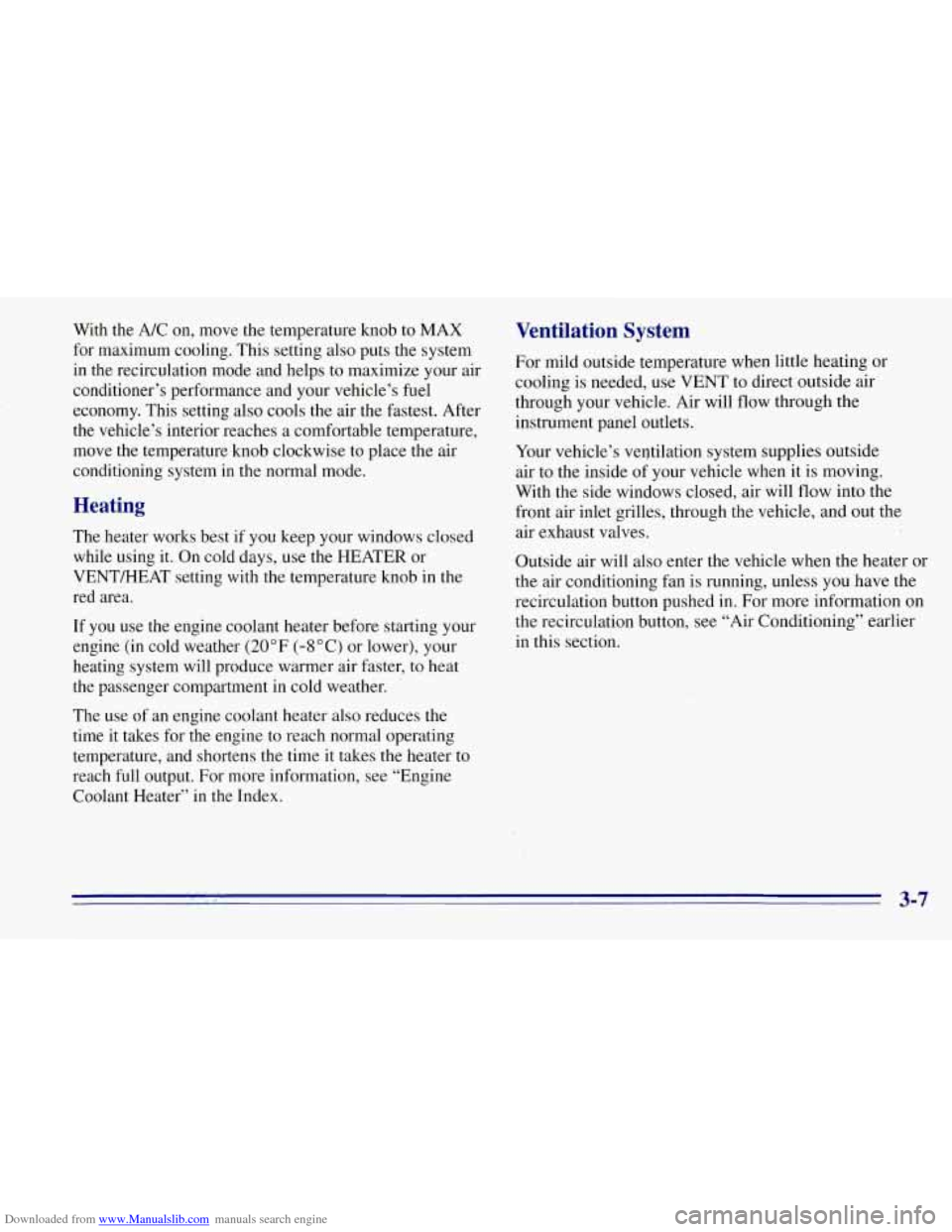Page 115 of 403

Downloaded from www.Manualslib.com manuals search engine Cigarette LightedAshtrays
The front ashtray is located at the bottom of the
instrument panel. Pull on the bottom
of the ashtray door
to open it.
NOTICE:
If you store paper or other things that burn in
your ashtrays, they could be
set on fire by
cigarettes or other smoking materials. That could
cause a fire and possibly damage your ‘vehicle.
Do
not store papers and other things that burn in
your ashtrays.
To use the cigarette lighter, push it in all the way, and let
go. When it’s ready, it will pop back by itself.
NOTICE:
Holding a cigarette lighter in with your hand
while
it is heating can make it overload,
damaging the lighter and the heating element.
Just push the lighter all the
way in and let go.
When it’s done,
it will pop back by itself.
To remove the front ashtray, pull on the front of the
ashtray insert. Then slide the insert out
of the ashtray door.
To use a rear ashtray, if you have them, pull at the top of
the ashtray door
to flip the door open.
To remove a rear ashtray, if you have them, press down
on the inside tabs and open the door fully.
2-52
Page 117 of 403
Downloaded from www.Manualslib.com manuals search engine Instrument Panel
2-54
Page 118 of 403
Downloaded from www.Manualslib.com manuals search engine A. Dome Lamp Switch
B. Lamp Controls
C. Air Vents
D. Multifunction Lever
E. Instrument Cluster
E Gearshift Lever
G. Audio ,System
H. Comfort Control System
I. Glove
Box
J. Storage Tray
K. Ashtray
L. Cupholder
M. Power Outlets
N. Storage Area or Optional. Compact Disc Player
0. Rear Window Defogger Switch
P. Tilt Lever
Q. Parking Brake Release Handle
R. Hood Release
S. Fuse Panel
2-55
Page 122 of 403

Downloaded from www.Manualslib.com manuals search engine Air Bag Readiness Light
There is an air bag readiness light on the instrument
panel, which shows AIR BAG. The system checks
the air bag’s electrical system for malfunctions. The
light tells you if there is an electrical problem. The
system check includes the air bag sensors, the air bag
module, the wiring and the diagnostic module. For
more information on the air bag system, see “Air Bag”
in the Index.
AIR
BAG
You will see this light flash
for a few seconds when you
turn your ignition to
RUN
or START. Then the light
should
go out. This means
the system is ready.
If the air bag readiness light doesn’t come on when you
start your vehicle, or stays on, or comes on when you
are driving, your air bag system may not work properly.
Have your vehicle serviced right away.
Charging System Warning Light
I-+I
The charging system
warning light should come
on briefly when you turn on
the ignition, before starting
the engine, as a check to
show you it is working.
After the engine starts, the light should
go out. If it stays
on or comes on while you are driving, you may have a
problem with your charging system. It could indicate a
problem with the alternator drive belt, or some other
charging system problem. Have it checked right away.
Driving while this light is on could drain your battery.
If you must drive a short distance with this light
on, it
helps to turn off all your accessories, such as the radio
and air conditioner.
2-59
Page 133 of 403

Downloaded from www.Manualslib.com manuals search engine Mode Knob
The right knob on the control panel allows you to
choose the direction
of air delivery. The control knob
can
be placed in any position between any two mode
settings to blend the flow of air.
+e
/J VENT This setting directs air through the
instrument panel outlets.
+’ VENT/HEAT Use this setting to divide airflow
between the floor outlets and instrument panel outlets.
+No HEATER: This setting directs air through the
floor outlets.
+fl DEFOG: This setting directs air to the heater
outlets and toward the windshield.
.+.
w.
DEFROST This setting directs air toward
the windshield.
Optional Climate Control System
Fan Knob
The knob on the left side of the heating system control
panel controls the fan speed. The
knob has four speed
positions. To increase airflow, move the knob toward
HI.
To decrease airflow, move it toward LO. To turn the
fan off, move the knob to
OFF. If you have the air
conditioner on, moving
the fan knob to OFF also turns
off the
A/C compressor.
3-2
Page 134 of 403

Downloaded from www.Manualslib.com manuals search engine Temperature Knob
The middle knob on the control pane-1 lets you select
the relative temperature of the air flowing into the
passenger area of your vehicle. This knob will allow you
to adj.ust the relative air temperature independently of
the function knob setting, Move the knob clockwise
toward the red area for warmer air. Move the knob
counterclockwise toward the blue area for cooler air.
Mode Knob
The right knob on the control panel allows you to
choose the direction of air delivery. The control knob
can be placed in any position between any two mode
settings to blend the flow of air.
+e
# VENT This setting directs air through the
instrument panel outlets.
+’ VENTMEAT Use this setting to divide airflow.
between the floor outlets and instrument panel outlets.
+e
HEATER: This setting directs air through the
floor outlets.
+# DEFOG: This setting directs air to the heater
outlets and toward the windshield.
9 DEFROST This setting directs air toward
the windshield.
w.
Rear Air Conditioning and Heating Systems
(Suburban)
’
If your vehicle has either or both of these systems, you
can increase and decrease the airflow at the rear vents.
Depending on the system
you have and the setting
selected,
you can send cooled or heated air to the rear of
the vehicle.
Rear Air Conditioning (Without Rear Heater)
If your vehicle has rear air conditioning (without rear
heater), the controls are located above the front and
second seats. The front and rear overhead controls let
you increase and decrease the airflow at the rear vents.
To operate the rear air conditioning system, the front air
conditioning system must be on. With the front air
conditioning system off, the rear system controls can be
used to circulate air in the rear of the vehicle.
3-3
Page 136 of 403
Downloaded from www.Manualslib.com manuals search engine Rear Heater (Without Rear Air Conditioning)
If you have a rear heater
(without rear air
conditioning), the control
switch is located on the
instrument panel.
To increase and decrease the flow of heated air to the
rear floor vents, move the switch marked REAR HEAT
to the blower speed you want.
The knob has three speed positions. To increase the flow
of heated air, move the switch toward HIGH. To
decrease the
flow of heated air, move it toward LOW. To
turn the fan off, move the switch to OFF.
Rear Air Conditioning and Rear Heater
If your vehicle has the rear air conditioning and rear
heater system combination, controls are provided to
regulate temperature, location and speed
of the airflow.
To adjust the air temperature, turn the temperature knob
on the right of the control panel.
For warmer air, turn the knob clockwise toward the red,
and for cooler air, turn the knob counterclockwise.
3-5
Page 138 of 403

Downloaded from www.Manualslib.com manuals search engine With the A/C on, move the temperature knob to MAX
for maximum cooling. This setting also puts the system
in the recirculation mode and helps to maximize your air
conditioner’s performance and your vehicle’s fuel
economy. This setting also cools the air the fastest. After
the vehicle’s interior reaches a comfortable temperature,
move the temperature knob clockwise to place the air
conditioning system in the normal mode.
The heater works best if you keep your windows closed
while using it. On cold days, use the HEATER or
VENT/HEAT setting with the temperature knob in the
red area.
If you use the engine coolant heater before starting your
engine (in cold weather (20°F (-8OC) or lower), your
heating system will produce warmer air faster, to heat
the passenger compartment in cold weather.
The use of an engine coolant heater also reduces the
time it takes for the engine to reach normal operating
temperature, and shortens the time it takes the heater to
reach full output. For more information, see “Engine
Coolant Heater” in the Index. Ventilation System
For mild outside temperature when little heating or
cooling is needed, use VENT to direct outside air
through your vehicle. Air will flow through the
instrument panel outlets.
Your vehicle’s ventilation system supplies outside
air to the inside
of your vehicle when it is moving.
With the side windows closed, air will flow into the
front air inlet grilles, through the vehicle, and out the
air exhaust valves.
Outside air will also enter the vehicle when the heater or
the air conditioning fan is running, unless you have the
recirculation button pushed in. For more information
on
the recirculation button, see “Air Conditioning” earlier
in this section.
- .. G 3-7